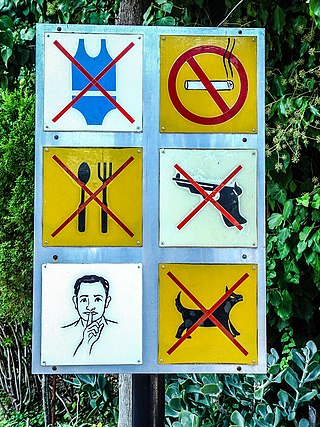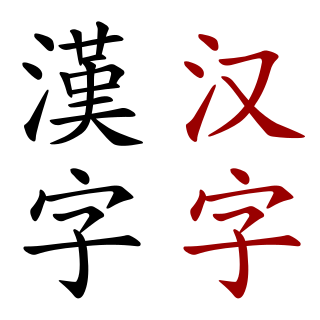Hiragana is a Japanese syllabary, part of the Japanese writing system, along with katakana as well as kanji.

An ideogram or ideograph is a graphic symbol that represents an idea or concept, independent of any particular language, and specific words or phrases. Some ideograms are comprehensible only by familiarity with prior convention; others convey their meaning through pictorial resemblance to a physical object, and thus may also be referred to as pictograms.
The term kana may refer to a number of syllabaries used to write Japanese phonological units, morae. Such syllabaries include (1) the original kana, or magana, which were Chinese characters (kanji) used phonetically to transcribe Japanese, the most prominent magana system being man'yōgana (万葉仮名); the two descendants of man'yōgana, (2) hiragana, and (3) katakana. There are also hentaigana, which are historical variants of the now-standard hiragana. In current usage, 'kana' can simply mean hiragana and katakana.

Kanji are the logographic Chinese characters taken from the Chinese script, and used in the writing of Japanese. They were made a major part of the Japanese writing system during the time of Old Japanese and are still used, along with the subsequently-derived syllabic scripts of hiragana and katakana. The characters have Japanese pronunciations; most have two, with one based on the Chinese sound. A few characters were invented in Japan by constructing character components derived from other Chinese characters. After World War II, Japan made its own efforts to simplify the characters, now known as shinjitai, by a process similar to China's simplification efforts, with the intention to increase literacy among the common folk. Since the 1920s, the Japanese government has published character lists periodically to help direct the education of its citizenry through the myriad Chinese characters that exist. There are nearly 3,000 kanji used in Japanese names and in common communication.

In a written language, a logogram, logograph, or lexigraph is a written character that represents a word or morpheme. Chinese characters are generally logograms, as are many hieroglyphic and cuneiform characters. The use of logograms in writing is called logography, and a writing system that is based on logograms is called a logography or logographic system. All known logographies have some phonetic component, generally based on the rebus principle.

Sumerian is the language of ancient Sumer. It is one of the oldest attested languages, dating back to at least 2900 BC. It is accepted to be a local language isolate and to have been spoken in ancient Mesopotamia, in the area that is modern-day Iraq.
The names for chemical elements in East Asian languages, along with those for some chemical compounds, are among the newest words to enter the local vocabularies. Except for those metals well-known since antiquity, the names of most elements were created after modern chemistry was introduced to East Asia in the 18th and 19th century, with more translations being coined for those elements discovered later.
Okurigana are kana suffixes following kanji stems in Japanese written words. They serve two purposes: to inflect adjectives and verbs, and to force a particular kanji to have a specific meaning and be read a certain way. For example, the plain verb form 見る inflects to past tense 見た, where 見 is the kanji stem, and る and た are okurigana, written in hiragana script. With very few exceptions, okurigana are only used for kun'yomi, not for on'yomi, as Chinese morphemes do not inflect in Japanese, and their pronunciation is inferred from context, since many are used as parts of compound words (kango).
Gairaigo is Japanese for "loan word", and indicates a transcription into Japanese. In particular, the word usually refers to a Japanese word of foreign origin that was not borrowed in ancient times from Old or Middle Chinese, but in modern times, primarily from English, Portuguese, Dutch, and modern Chinese dialects, such as Standard Chinese and Cantonese. These are primarily written in the katakana phonetic script, with a few older terms written in Chinese characters (kanji); the latter are known as ateji.
Phono-semantic matching (PSM) is the incorporation of a word into one language from another, often creating a neologism, where the word's non-native quality is hidden by replacing it with phonetically and semantically similar words or roots from the adopting language. Thus the approximate sound and meaning of the original expression in the source language are preserved, though the new expression in the target language may sound native.

The modern Japanese writing system uses a combination of logographic kanji, which are adopted Chinese characters, and syllabic kana. Kana itself consists of a pair of syllabaries: hiragana, used primarily for native or naturalised Japanese words and grammatical elements; and katakana, used primarily for foreign words and names, loanwords, onomatopoeia, scientific names, and sometimes for emphasis. Almost all written Japanese sentences contain a mixture of kanji and kana. Because of this mixture of scripts, in addition to a large inventory of kanji characters, the Japanese writing system is considered to be one of the most complicated currently in use.

Maya script, also known as Maya glyphs, is historically the native writing system of the Maya civilization of Mesoamerica and is the only Mesoamerican writing system that has been substantially deciphered. The earliest inscriptions found which are identifiably Maya date to the 3rd century BCE in San Bartolo, Guatemala. Maya writing was in continuous use throughout Mesoamerica until the Spanish conquest of the Maya in the 16th and 17th centuries.
All Chinese characters are logograms, but several different types can be identified, based on the manner in which they are formed or derived. There are a handful which derive from pictographs and a number which are ideographic in origin, including compound ideographs, but the vast majority originated as phono-semantic compounds. The other categories in the traditional system of classification are rebus or phonetic loan characters and "derivative cognates". Modern scholars have proposed various revised systems, rejecting some of the traditional categories.

In modern Japanese, ateji principally refers to kanji used to phonetically represent native or borrowed words with less regard to the underlying meaning of the characters. This is similar to man'yōgana in Old Japanese. Conversely, ateji also refers to kanji used semantically without regard to the readings.
A determinative, also known as a taxogram or semagram, is an ideogram used to mark semantic categories of words in logographic scripts which helps to disambiguate interpretation. They have no direct counterpart in spoken language, though they may derive historically from glyphs for real words, and functionally they resemble classifiers in East Asian and sign languages. For example, Egyptian hieroglyphic determinatives include symbols for divinities, people, parts of the body, animals, plants, and books/abstract ideas, which helped in reading, but none of which were pronounced.
Dingir is a Sumerian word for "god" or "goddess". Its cuneiform sign is most commonly employed as the determinative for religious names and related concepts, in which case it is not pronounced and is conventionally transliterated as a superscript "d" as in e.g. dInanna.
A Sumerogram is the use of a Sumerian cuneiform character or group of characters as an ideogram or logogram rather than a syllabogram in the graphic representation of a language other than Sumerian, such as Akkadian or Hittite. Sumerograms are normally transliterated in majuscule letters, with dots separating the signs. In the same way, a written Akkadian word that is used ideographically to represent a language other than Akkadian is known as an Akkadogram.

The Chinese family of scripts are writing systems descended from the Chinese oracle bone script and used for a variety of languages in East Asia. They include logosyllabic systems such as the Chinese script itself, and adaptations to other languages, such as kanji (Japanese), Hanja (Korean), chữ Hán and chữ Nôm (Vietnamese) and Sawndip (Zhuang). More divergent are Tangut, Khitan large script, and its offspring Jurchen, as well as the Yi script, which were inspired by Chinese although not directly descended from it. The partially deciphered Khitan small script may be another. In addition, various phonetic scripts descend from Chinese characters, of which the best known are the various kana syllabaries, the zhuyin semi-syllabary, nüshu, and some influence on hangul.

A writing system is a method of visually representing verbal communication, based on a script and a set of rules regulating its use. While both writing and speech are useful in conveying messages, writing differs in also being a reliable form of information storage and transfer. Writing systems require shared understanding between writers and readers of the meaning behind the sets of characters that make up a script. Writing is usually recorded onto a durable medium, such as paper or electronic storage, although non-durable methods may also be used, such as writing on a computer display, on a blackboard, in sand, or by skywriting. Reading a text can be accomplished purely in the mind as an internal process, or expressed orally.
Heterogram is a term used mostly in the study of ancient texts for a special kind of a logogram consisting of the embedded written representation of a word in a foreign language, which does not have a spoken counterpart in the main (matrix) language of the text. In most cases, the matrix and embedded languages share the same script. While from the perspective of the embedded language the word may be written either phonetically or logographically, it is never a phonetic spelling from the point of view of the matrix language of the text, since there is no relationship between the symbols used and the underlying pronunciation of the word in the matrix language.













